On Light Music Before Cinema
Long before the twentieth century, scientists and musicians were already dreaming of an art form addressing a combination of vision and hearing. The long birth of light music begins with the first associations of musical intervals and colours in Antiquity and continues through to various propositions of colour keyboards in the late nineteenth century.
Musica Universalis I
Antiquity
We must go back to Pythagoras to retrace the beginnings of an analogy between sounds and colours. It all begins when the philosopher decides to investigate the musical intervals by subdividing a monochord into simple numerical relationships. Thus takes the Pythagorean scale, built from pure fifths (3:2), the most consonant numerical ratio after the octave (2:1). But within this ancient investigation of the music scale also lies the intentions of a much more ambitious programme: the harmony of the spheres.
The theory surrounding the harmony of the spheres rests on a geocentric conception of the universe in which certain numerical relations condition phenomena, ranging from the positioning of the planets to the whole spectrum of human senses and musical intervals. Benoit Kullman summarizes the theory in a few lines:
For the Pythagoreans the movement of the stars ensures the harmony of the world. Around the Earth in the center of the Universe, the stars move on circular trajectories, each of which is conceived as a vibrating string, the note of which must be in harmony with that of the other stars. The seven stars (Moon, Mercury, Venus, Sun, Mars, Jupiter, Saturn) and the sphere of the stars play a complete and perfect musical scale. (Kullmann 2009, 5)

The colours also align to the tuning of this music. Pythagoras establishes a correspondence between the positioning of the planets, the colours and the musical intervals (Sylvestrini 1994). Already in Antiquity, Aristotle had proposed an analogy between consonant and dissonant intervals, and pleasant and shocking colours, as well as a system of colour organization ranging from white to black through various colours (yellow, orange, red, violet purple, green, very dark blue) like the succession of colours in the course of a day (Aristotle 1863).
Pythagoras’ idea of universal proportions and various parallels between harmony of colours and musical intervals survived well into the seventeenth century. The list of correspondence theorists is long and diverse in propositions. In 1492, a mode-colour association is proposed by Franchino Gaffurio (1451–1522). The Phrygian mode is associated with the colour orange, the Lydian with red and the Dorian with the crystalline colours. Nearly 60 years later, in 1550 Gerolamo Cardano (1501–1576) proposes a system of correspondence between colours, flavours and planets. A subsequent proposal made by Marin Cureau de la Chambre (1596–1669) aims at an association between colours and musical intervals (Fig. 1).
Kircher, Newton and Castel
Athanase Kircher (1601–1680) proposes in Ars magna lucis and umbrae (The Great Art of Light and Shadow) an organization of colours symbolized by imbrications of half-arcs. In 1650 he publishes the Musurgia Universalis, a collection of studies on the history of music and musical instruments that includes an attempt at a scientific explanation of harmony and sound. According to Kircher, musical harmony reflects the divine proportions of the universe. For him, sound and light is one and the same phenomenon. He seeks to combine the intervals of the six-note musical scale (hexachord) with colours. The colour white is the unison, gold is the fifth.
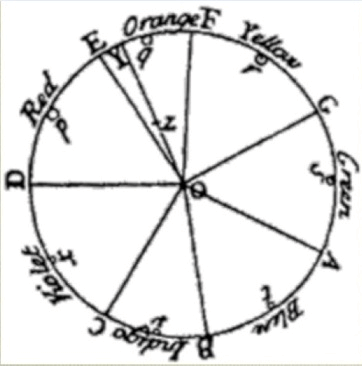
Later in the seventeenth century, the proposals of Isaac Newton (1642–1726) will lay the foundations for the modern understanding of colour. Newton identifies a series of colours obtained by refraction by means of a crystal prism. But even then, the scientist does not resist Pythagoras’ appealing idea of a universal relationship between musical pitches and colours. Newton’s colour wheel shows the decomposition of white light in different colours (Fig. 2). Note that each colour is associated with pitches of the Western musical scale (C-D-E-F-G-A-B-C).
In parallel to Newton’s investigations, Father Louis-Bertrand Castel (1688–1757) implements Kircher’s analogy between sound and light for the design of his ocular harpsichord. Thus begins a rich succession of proposals on light instruments, the ramifications of which will eventually influence the orchestration of Scriabin’s Prometheus: The Poem of Fire in the early twentieth century. If the first inventions are designed to investigate the relationship between musical intervals and colours, they quickly become instruments to perform with light in the same way one can play music. Thus an art of colour and movement takes shape in musical circles: colour music.
Light Keyboards
Castel and the Ocular Harpsichord
In the November 1725 edition of the Mercure de France, the Jesuit Castel proposes the ocular harpsichord, an instrument which, according to him, would enable a deaf person to appreciate and judge the beauty of a piece of music. It was not until 1734 that the first model was supposedly built. The publication of an article on the subject in the Journal de Trévoux the following year attracted even the attention of Telemann, who later translated it into German. The model of correspondence between musical intervals and colours of Castel is both complex and surprising, to say the least.

Through a series of fierce accusations with respect to Newton’s proposals on colour, Castel’s prism (Fig. 3) does not seem to refract light, but rather to make a series of twelve shades appear at the end of the light traces in the image: cramoisi, rouge, orangé, fauve, jaune, olive, vert, céladon, bleu, violant, agathe, violet (Castel 1740). Benoit Kullmann makes amusing remarks on the subject:
The gentle madness of Father Castel oscillates between paraphrenia and Mythomania to the point that he pretends to have given himself concerts of prisms, and delivers in passing the recipe of olfactory, gustatory, and tactile harpsichords. (Kullmann 2009)
Let us quote Voltaire about Father Castel:
Vous avez affaire à un homme qui fait de la musique pour les yeux. Il peint des menuets et de belles sarabandes. Tous les sourds de Paris sont invités au concert qu’il leur annonce depuis douze ans.
On the other hand, this same Voltaire also maintains an interest in Pythagoras’ universal correspondences between musical intervals and colours: “This secret analogy between light and sound gives reason to suspect that all things of nature have hidden relations that may be discovered some day” (Voltaire cited in Thuilier 1997).
Alexander Rimington and the Colour Organ

It was not until the end of the 19th century, alongside the democratization of electricity, that light keyboards became fully functional. In 1893, the famous colour organ of English painter Alexander Wallace Rimington (1854–1918) was built. It is an imposing device more than three metres high with coloured lamps above a five-octave keyboard (Fig. 4). The colours are mapped to the keyboard according to an equal subdivision of the light spectrum. An interesting fact to note is that Rimington’s instrument produces no sound and its author recommends not accompanying its use with music in order to be able to better appreciate the colour movements. In his 1912 book Colour-Music, The Art of Mobile Colour, Rimington discusses the correspondence between colour and music without ever referring to the harmony of the spheres. He evokes the periodic nature of the two phenomena and then deals with the psychological effect of colours and sound. Rimington suggests above all an art of light, which he calls “colour-art”, already foreshadowing Thomas Wilfred’s “lumia”.
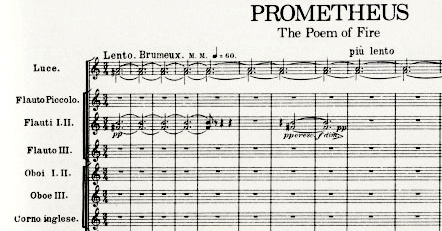
Several reports have noted that Russian composer Alexander Scriabin’s (1871–1915) premiere of his orchestral work Prometheus in 1911 was performed without the clavier à lumières part, as it would seem that the device was not in a functioning condition for live execution (Peacock 1988). In 1914, attempts with Rimington to realize the instrument (tastiera per luce) were put on hold by the war. It is finally at Carnegie Hall in 1915 that the public could appreciate this work in its entirety, considered to be the first to include a part for a light instrument within the orchestra (Fig. 5). Engineer Preston S. Millar from General Electric supervised the realization of the instrument used for the premiere. This instrument, called the chromola and designed especially for the work of Scriabin, would popularize light keyboards in America and pave the way for a multitude of similar proposals. These include the two-octave controller (1920) for Adrian Klein’s scenic lighting design and Mary Hallock-Greenewalt’s Sarabet (1919), whose research even lead to a patent on light notation.
About Synesthesia
There is a controversy surrounding Scriabin’s supposed synesthesia. 1[1. Synesthesia, or coloured vision, is a neurological condition by which two or more senses are associated. When the senses involve vision and hearing, there is talk of synopsy or colourful hearing. Many musicians belong to the list of famous synesthetes: Olivier Messiaen, Jean Sibelius, Franz Liszt, Alexander Scriabin as well as Thom Yorke, Pharrell Williams and Marina Diamandis.] By a phenomenon that may seem strange nowadays, colourful vision or synopsy was fashionable in the artistic circles of the time. Thus the subdivision of the luminous spectrum according to the cycle of fifths, as observed in Prometheus, leaves some doubt as to the condition of the composer. Synopsy is known to present fortuitous associations between sounds and colours for each synesthete and the very symmetrical propositions of Scriabin are more reminiscent of a compositional organization than a neurological condition. Moreover, Scriabin’s proposal is but one of a number of approaches to the organization of colour correspondence since the early 1700s (Fig. 6). Immediately obvious is the diversity of proposals, if not their arbitrariness. Of this profusion of approaches really only one association emerges that corresponds to physical phenomena: the luminous spectrum is divided according to the equal-tempered Western chromatic scale. The rainbow thus occupies the precise space of an octave.
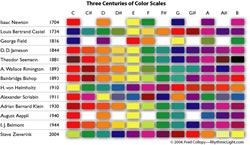
But in reality the correspondences between sounds and colours are difficult to explain by reason. The two phenomena are of a periodic nature, but frequency ranges (20–20,000 Hz for sound and 400–800 THz 2[2. 1 Terahertz = 1,000,000,000,000 Hz.] for light) as well as wavelengths (0.017–17.0 m for sound and 400–700 nm for light) do not overlap and their relationship suggests nothing other than a fortuitous association. Moreover, the frequency range of visible light (1 octave) is very different from that of sound (10 octaves and more). Finally, the ear is able to hear several simultaneous sound frequencies separately, whereas human vision rather combines different light frequencies in a single resulting colour. The various associations between colours and musical intervals seen so far, whether these come from the music of the spheres, from a delusional prism or from a fashionable neurological condition, testify more to a desire to mix sounds and colours than to physical phenomena. In the end, the association of sound and image can be seen to be a phenomenon that belongs almost entirely to culture.
Thomas Wilfred and the Clavilux
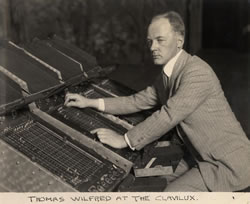
A new stage was reached in 1922 with Thomas Wilfred’s (1889–1968) Clavilux (Fig. 7). The correspondences between intervals and colours are completely neglected in favour of an interest directed strictly towards the manipulation of light. The instrument strangely resembles our modern lighting consoles, where the performer manipulates a series of potentiometers. As with Rimington’s Colour Organ, Wilfred’s work, which he called “lumia”, is meant to be observed without the support of music. 3[3. See Dave Payling’s discussion of “Lumia and Visual Music,” also in this issue.] That being said, Wilfred gave performances accompanied by music, including one in 1926 with Rimsky-Korsakov’s Scheherazade performed by the Philadelphia Orchestra (Peacock 1988).
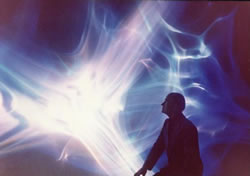
Wilfred’s works also include numerous borrowings from music. Firstly, the notation that strangely evokes the graphic scores of the 1960s while at the same time preceding them by at least 30 years. Secondly, the titles of the works contain opus numbers and their format ranges from five to ten minutes. Finally, the arrangement of six to eight pieces per performance heavily suggests the outline of a musical concert. Wilfred was also a professional lute player and he somehow created an art form feeding on his own musical experience.
Musica Universalis II
It does not matter that the scientific basis of correspondences between sounds and colours seems rather thin. The art of colour and movement shares with music a space in culture whose roots go back to Antiquity. Long before appearing in cinema animation, laser shows, luminous devices adorning the ceilings of nightclubs, audiovisual composition or kinetic art, it is first through experimental instrument design that light music emerged.
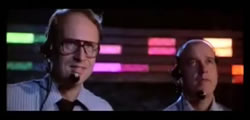
Light music and its first universal pretensions from Antiquity are even present in recent Hollywood cinema, for example in the film Close Encounters of the Third Kind by Steven Spielberg. For the occasion of the first contact between human beings and extraterrestrials, it is neither more nor less than by means of an immense colour organ placed at the top of a mountain plateau that we welcome the inhabitants arriving on Earth from outer space. In a completely hallucinatory scene, humans play on a light keyboard a melody of five coloured pitches. Once, twice, then a hesitant response from the spacecraft can be heard. Suddenly all the windows around are shattered by the power of sound and then everything goes wild. The extraterrestrials are now virtuosos of light keyboard. NASA’s music analysis team, proud to serve, is making live set theory analysis: “Six quavers then pause! Semi-quavers! Man I hope somebody’s getting all this data!” Father Castel sketches a tender smile from beyond. The first peaceful contact between human beings and extraterrestrials is achieved through a colour music jam. Maybe the music of the spheres really exists after all.
Bibliography
Aristotle. Météorologie. Trans. Jean Barthélémy Saint-Hilaire. Dandurand, 1863.
Castel, Louis-Bertrand. L’optique des couleurs, fondée sur les simples observations et tournée surtout à la pratique de la peinture, de la teinture et des autres arts coloristes. Mercure de France, 1740.
Haller, Robert. First Light. New York: Anthology Film Archives, 1998.
Kullmann, Benoit. De la musique des sphères aux couleurs de l’arc-en-ciel. Neroland-Art, 2009.
László, Alexander. Color-Light Music. 1925.
Peacock, Kenneth. “Instruments to Perform Color-Music: Two Centuries of Technological Experimentation.” Leonardo 21/4 (February 1988), pp. 397–406.
Piché, Jean. “De la musique et des images.” Circuit 13/3 (2003) “Électroacoustique : Nouvelles Utopies,” pp. 41–50.
Rimington, A. Wallace. Colour-Music: The art of mobile colour. Hutchinson, 1912.
Silvestrini, Narciso. IdeaColour. Zurich: Baumann and Stromer, 1994.
Scriabin, Alexander. Prométhée ou le poème du feu (1910). Éditions Russes de Musique, 1911.
Thuilier, Pierre. La revanche des sorcières. L’irrationnel et la pensée scientifique. Éditions Belin, 1997.
Social top